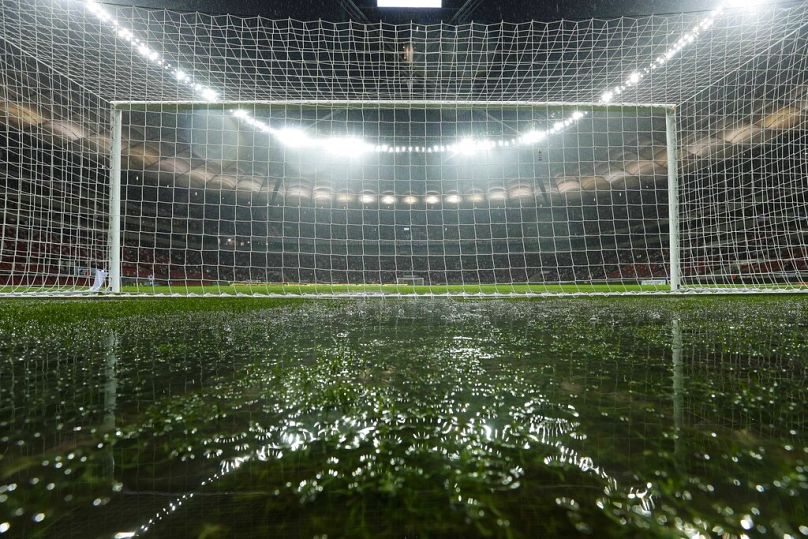Vanishing jerseys and flooded pitches: Why football is responsible for its own climate crisis

Football is more than just a sport. For fans of the beautiful game, it’s almost a religion, dedicatedly tuning in to watch matches and avidly following every move from their team.
FIFA says around five billion people worldwide count themselves as football fans. The 2022 World Cup Final in Qatar was watched by 1.5 billion viewers, and 220 million fans go to matches each year. Talked about in every corner of the world, as an industry, football is worth €35.3 billion in Europe alone.
But football has a dirty secret, and it’s been highlighted in a new report, ‘Dirty Tackle’, by Scientists for Global Responsibility and the New Weather Institute.
The report evaluates that the global football industry is responsible for between 64 and 66 million tonnes of CO2 each year. That’s as much as the entire nation of Austria.
Footballers and teams already impacted by the impacts of climate change are now raising awareness to their fanbase in creative ways.
Why football is a ‘dirty game’ for the planet
The Dirty Tackle report is the first time football’s CO2 emissions have been so closely examined and shows a worrying trend towards higher emissions from the industry.
“This research documents compelling evidence that football is a major polluter and its contribution to climate change is growing,” says Dr Stuart Parkinson. “It also shows that there is little indication that decision-makers are prepared to adequately assess the game’s pollution problem, let alone take the steps necessary to reduce it.”
Where do football’s greenhouse gas emissions come from?
Three major areas of emissions from football were identified in the report.
The first is transport, which is a major and easily understandable source of emissions. The research estimates that an average match in a domestic men’s league would generate around 1,700 tonnes of CO2.
Around half of this was due to fan travel, which is mainly undertaken by car. However, when international games are considered, it rises by around 50 per cent due to more match attendees taking flights.
When it’s a big match, like the men’s World Cup finals, these emissions can surge up to 42 times higher than a domestic game, due to fans flying in from all over the world.
Teams themselves need to be accountable for their emissions too. In 2023, BBC Sport found evidence of 81 short-haul domestic flights by English Premier League teams in just two months. Some of these flights were as short as just 27 minutes.
Researchers suggest that expansions in international fixtures, such as for the UEFA Nations League - are causing football travel emissions to grow. They call on the industry to reverse this expansion and focus on smaller, more regional tournaments instead.
Secondly, the construction of stadiums has a great deal of associated carbon emissions. For the 2022 FIFA World Cup, seven new permanent stadiums were erected, with estimates that the emissions linked to their construction totalled 1.6 million tonnes of CO2.
The 2034 World Cup, set to be held in Saudi Arabia, will see the construction of 11 new stadiums. Carbon Market Watch says, “The environmental impact of this fresh construction will be off the scale.”
The final source, and one which has been tricky to assess in the past, is emissions from sponsorship deals.
In April 2024, FIFA signed a deal with the world’s largest oil company Aramco. UEFA has a long-running sponsorship deal with Qatar Airways, and several clubs are sponsored by high-carbon sectors, including oil and gas corporations, airlines, car manufacturers, and fast food chains.
All this high-carbon finance pouring into the sport is further normalising climate-harming behaviours to its fans, says the report, such as driving large SUVs and travelling by air. It calculates that 75 per cent of football’s emissions are driven by these sponsorship deals.
“FIFA’s willingness to let Saudi Arabia improve its reputation through football is isolating players, fans and the planet,” says Dutch footballer Tessel Middag. “Securing a future for football, where everyone can play it and enjoy it, requires real leadership from the very top.”
The last country without a football team designs a ‘vanishing’ shirt to press home its message
Out in the middle of the Pacific Ocean, the Marshall Islands, home to just 42,000 people, is the only one of the 193 UN member states without an officially recognised national football team.
This isolated sprawl of atolls has players, a football field and even a federation to oversee the sport. But recognition from bodies like FIFA takes time, and time is something the Marshall Islands do not have, as rising sea levels threaten to obliterate the islands before the team has played a single international game.
With the whole country sitting at less than six feet in average elevation, the islands are at extreme risk from rising sea levels. Just a one-metre rise would see the loss of around 80 per cent of the Majuro Atoll, home to half the nation’s population. According to NASA, sea levels have already risen by 10cm over the last 30 years.
To draw attention to their plight, the Marshall Islands Soccer Federation (MISF) worked with sports brand PlayerLayer to launch a new kit. But this was no regular kit. Dubbed the ‘2030 No Home’ jersey, the shirt began to vanish throughout the ad campaign.
At first, it was just a small piece, barely noticed by fans watching the campaign. Over the coming days, more pieces began to disappear, mirroring the gradual but devastating loss the islands are likely to experience as climate change begins to eat away at their home.
The kit itself is full of cultural symbolism. Depictions of outrigger canoes, great white sharks and Marshallese flora and fauna pepper the shirt’s surface, while the number 1.5 signifies the global temperature commitment made under the Paris Agreement.
“We want to create a soccer team, not only to give our people a source of pride when they see us compete,” says MISF, “but to also bring attention to the plight of the islands, using the world’s most popular sport.”
Without adaptation measures, the Marshall Islands will be one of the first nations to face disaster from sea level rise. But it’s not the only nation under threat. Micronesia, the Maldives, Tuvalu, and Kiribati - all these low-lying Pacific island nations are all at risk.
What are football teams and players doing about climate change?
Climate and football aren’t two natural bedfellows, but they are quickly becoming well acquainted.
Already, teams around the world are becoming familiar with matches being called off for climate-related disruption: rain, frozen pitches, and high winds. The Football Association (FA) in England says around 100,000 grassroots matches are cancelled every year due to ‘poor pitches’ which are muddy, waterlogged, or otherwise unplayable.
Without action, research estimates that 25 per cent of the UK’s football pitches could be partially or totally flooded by 2050. Stadiums closer to the coast, such as Cardiff City stadium and Hull City’s MKM stadium could be completely submerged.
Individual footballers have already taken steps to push the message of climate change in their activities. Spanish player Héctor Bellerín promised to plant 3,000 trees for every Arsenal victory when he was in the squad, while Leeds player Patrick Bamford has adopted an earth-focused celebratory symbol.
In an Instagram post, Bamford explained that his ‘lightning bolt’ hand gesture is a symbol for the planet. “Celebrating with the bolt is my way of standing up for our earth,” says Bamford. “Climate change is a threat to sport and if we don't act, it's going to get worse.”
Some teams have already signed up to the UN Sports for Climate Action Framework, which gives clubs targets to halve their emissions by 2030 and strive for net zero by 2040.
Leading the way to more sustainable stadiums is Gloucestershire-based Forest Green Rovers. Powered by 100 per cent renewable energy, its stadium uses an organic pitch, cut by a solar-powered robot lawnmower, and uses recycled rainwater to reduce its use of mains water.
In 2018, Forest Green Rovers became the world’s first carbon-neutral football club, certified by the UN. But it’s not stopping there. The club, owned by British green energy industrialist Dale Vince, is building a new stadium almost entirely out of wood with trees, hedgerows, and wetland areas to improve biodiversity. When complete, it will have the lowest carbon footprint of any stadium in the world.
These are just a few examples, but there are many more, as well as dedicated organisations aiming to advance sustainability in football. However, the biggest impact would come from an issue both clubs and associations will struggle to deal with.
The ‘Dirty Tackle’ report suggests that, along with other mitigation measures, a major win would be for the sport to distance itself from sponsorship deals with highly polluting companies.
“We urgently need more ambition to win the ultimate cup of a stable climate where sport can have a future,” say the researchers. “Given the cultural reach of football, strong action in this sector could change the global conversation on climate issues, and help to stem the rising tide of climate disasters like that taking place in Los Angeles.”
A group of more than 100 leading women’s clubs has called for an end to the Aramco sponsorship deal with FIFA. Already, German club Bayern Munich dropped Qatar Airways as a shirt sponsor after fan protests. But football’s links with heavy polluters continue to tarnish its green credentials around the world.
Yesterday




